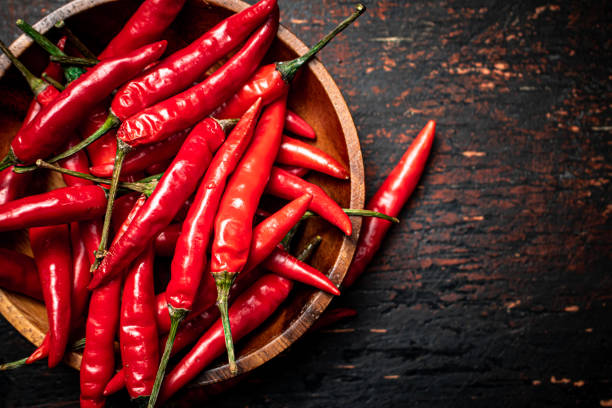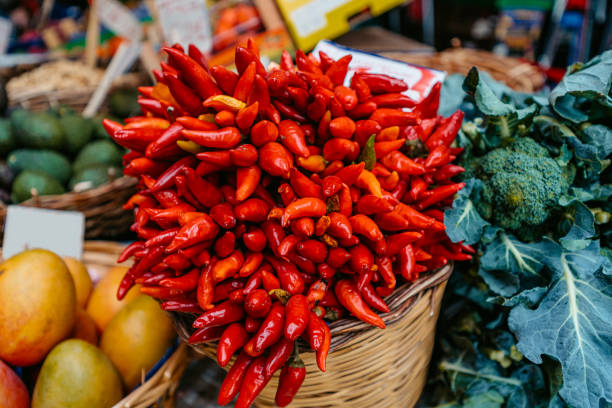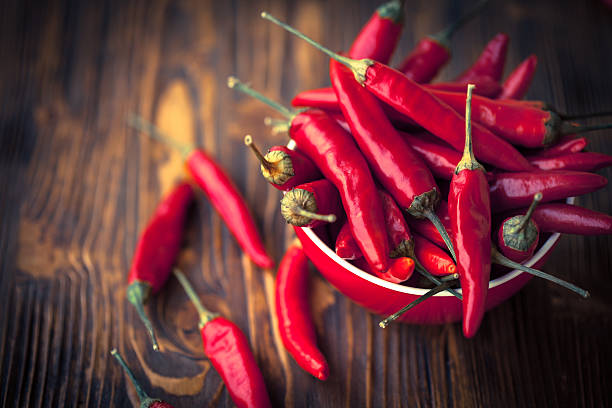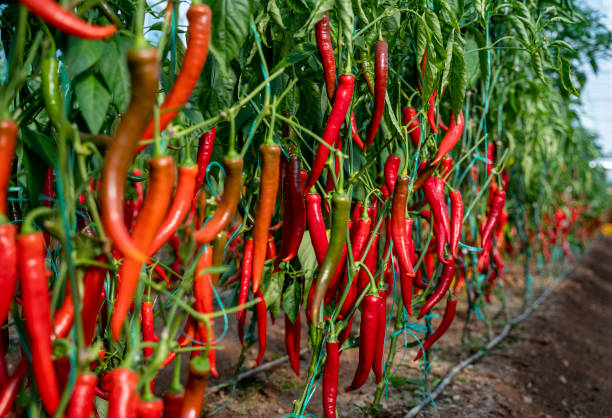Spicy ramen noodles have also been banned in some European countries due to the presence of chili peppers or excessive amounts of capsaicin. Are Peppers Really a Health Risk?
Last year, the Danish Food Authority banned the South Korean brand Instant Ramen Noodles due to the risk of acute poisoning. However, after investigations and experiments, some restrictions have been lifted by the country’s authorities.
Another case that recently made headlines was that a teenager in the United States recently suffered from underlying health problems after taking part in a spicy food challenge and later died.
Capsaicin is a cause for concern about spicy foods. It is an active ingredient in chillies, which gives a spicy taste to the food. But can eating too much capsaicin really cause poisoning?

What is capsaicin?
Capsaicin is a compound in pepper that gives a hot or spicy feeling. As a result, when we eat pepper, we have a sour or burning taste. It is part of a compound called capsaicin.
Although about 23 different capsaicinoids have been found in the pepper, the most potent of which is capsaicin.
The UK’s Food Standards Agency does not allow food manufacturers to add pure capsaicin to food. Because the country’s food authority considers pure capsaicin unsafe.
But the country’s food authority has not determined how much capsaicin can be used if it is naturally present in chili extract.

What are the symptoms of capsaicin?
Denmark is not the first country to warn against the use of high doses of capsaicin. Earlier, the Federal Institute for Risk Assessment in Germany (BFR) warned against eating excessive capsaicin.
With a pain receptor called TRPV activated, capsaicinoid can cause painful feelings and intense burning.
Also, taking capsaicin can cause a variety of symptoms. Studies have shown that high intake of capsaicinoids can cause heartburn, nausea, diarrhea, and abdominal and chest pain.
It may also cause other symptoms; Such as cold sweat, blood pressure fluctuations or severe headaches. However, there is not enough information about how much it can cause these symptoms.
A spokeswoman for the Federal Institute for Risk Assessment in Germany said: “In the absence of specific data on how much dose of capsaicin oid might trigger repercussions, no recommendations can be made for consumers, including health restrictions.” ”
However, based on data from studies conducted on humans, the BFR says, it can be estimated that taking 0.5 to 1 milligram or more of capsaicinoids may cause mild uncomfortable effects, such as feelings of fever, stomach or heartburn.
It can have adverse effects on the human body by eating 170 mg. The BFR also documented a case of a patient being hospitalized after consuming about 600 mg of capsaicinoids.
A 27-year-old man who participated in a chilli-eating competition in Berlin, Germany, ate four bhut jolokia or naga chillies and other spicy foods.
The bhut jolokia is considered to be the hottest chilli variety in the world.
Two and a half hours after eating the chilli, the person started feeling severe stomach swelling with abdominal pain. Later in the evening, he was taken to the emergency department of Helios Hospital in Berlin.
In the report, the doctors did not find any other problem, so they gave some painkillers only because of the pain. About 12 hours after eating the chilli, the man vomited and gradually his physical condition started improving.
However, such symptoms can not only be caused by eating capsaicin.
“Capsaicin can cause irritation, discomfort and pain for a very short period of time,” said Christian Moro, associate professor of pharmaceutical science at Bond University in Australia. ”
“If it gets in someone’s eyes, it can cause really intense burns and blurred vision. If you enter the body with breathing again, you may cough for a long time. It can also exacerbate illnesses like asthma. ”
Professor Morrow also said, “The symptoms that can be caused by taking capsaicin are not

How harmful are any symptoms?
The BFR says that excessive amounts of capsaicin can cause severe toxicity for children. However, there is no specific information about how much eating can cause this.
However, it is estimated that the lethal dose of capsaicin in humans can range from 500 to 5000 milligrams per kilogram of body weight.
If a person weighs 70 kg, the dose can be 35,000 milligrams. A 100-gram jalapeno pepper contains about 15 mg of capsaicin. The same amount of Scotch bonnet pepper contains about 260 milligrams. And Bhut Jolokia contains about 4000 milligrams per 100 grams of fresh chillies.
However, Professor Morrow says that there is no specific limit on the amount of capsaicin overdose.
Two types of capsaicin properties were observed in a 10-year review. Lab tests showed that capsaicin caused symptoms of stomach and liver cancer in mice. And gastric “microbleeding” has been found in the human body.
Again, some other studies did not show any of these symptoms.
However, an analysis of an overall review from 2022 concluded that spicy foods and chili peppers have no good or bad effects on health. The evidence presented in these reviews is not very standard.
Paul Bosland, a professor of plant and environmental sciences in New Mexico, said, “I’ve been asked many times, ‘Would I kill you by eating superhot peppers?'” There is no yes or no answer. He is one of the world’s leading experts in state university and pepper research.
“Peppers can really cause death, but most people’s bodies weaken long before they reach that stage,” he said. In other words, our body will expel food containing capsaicin before it reaches lethal levels.
“Many people can sweat, shiver, vomit or even feel dead after eating very hot peppers. “But even the most spicy pepper won’t kill you,” he said.

Is our body risk resistant?
As with many other foods and drinks, the reaction of capsaicin to a person’s body depends on several factors.
Capsaicin can cause different reactions in different people, says BFR. For example, children or people who eat very little spicy food will have the same effect on capsaicin as those who eat it regularly.
One study found that capsaicin is very painful for those who have irritable bowel syndrome or IBS (stomach problems). But not for healthy people.
Researchers conducted a type of study on 20 healthy people with IBS and 38 healthy people without IBS. At that time, they were fed a capsule of two grams of chilli.
It was found that people who did not have IBS had mild abdominal discomfort. But those who are infected with IBS have noticed excessive abdominal pain and irritation.
Also, people with gastrointestinal problems like reflux disease have capsa
A study in Taiwan found that regular consumption of capsaicin can reduce the symptoms of heartburn. Because then the body also gets used to it.
“Once two scientists working with peppers came to me. One is from China and the other is from India. They went to my laboratory,” Bosland said.
“I took them to lunch, and when we ate our enchiladas, the Chinese scientist said that when he went to India, the food there seemed to be more spicy than in China. “
“The Indian scientist said, ‘When I went to China, I felt the same spicy. “
Although both scientists are from countries known for spicy food. But they both thought the other’s food was spicy, Bosland said.
What are the health benefits?
History says that pepper has been used for health remedies, and capsaicin is also used in modern medicines.
Chilli extract is used to make medicines for many diseases including pain relief, migraine, headache. Researchers also recommend the use of capsaicin to prevent gastric and cancer.
However, capsaicin has potential adverse effects. But numerous studies have shown that regular consumption of capsaicin also has some health benefits due to its antioxidants and well-being properties, says Prof Morrow.
Studies have shown that capsaicin is very beneficial in reducing the risk of various diseases including high blood pressure, metabolic problems, obesity.
There’s also evidence to recommend taking capsaicin because of the symptoms of a gastric ulcer sometimes. This is because it can help prevent and heal gastric.
“It’s better to eat pepper than salt in food,” Morrow says. So pepper can be an excellent alternative to salt. ”
Although eating high doses of capsaicin may cause adverse reactions in some people, there is no evidence that eating too much peppermint or capsaicin can cause any difficult reactions other than the sour feeling.
Rather, if there is some capsaicin in our food, it is considered beneficial for the body.
But a mystery remains: China or India? Which country has the most spicy food? The answer, it seems, is that there will be a heated debate about this.